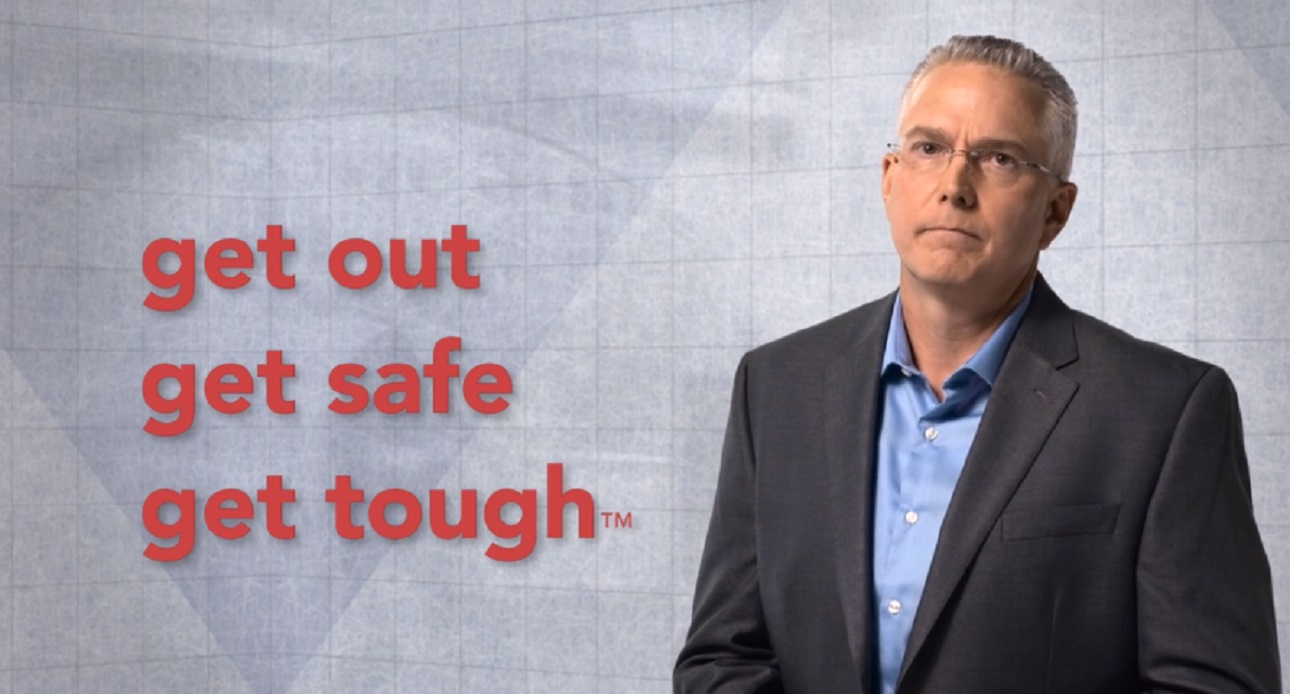Get Out, Get Safe, Get Tough™ -- the New Language of Workplace Violence Survival

Across the U.S., one in four HR professionals reported an incident of workplace violence in their organizations during the past year, according to a new survey by the Society of Human Resource Management (SHRM). The fact is unexpected acts of violence can happen anywhere and at any time. Although that can be a scary idea, it doesn’t have to leave us feeling helpless. SHRM found that employees feel safer on the job when they’ve received training on how to respond to workplace violence.
OSHA (U.S. Department of Labor’s Occupational Safety and Health Administration) defines workplace violence as “any act or threat of physical violence, harassment, intimidation, or other threatening disruptive behavior that occurs at the work site” and says that almost two million employees in the U.S. are victims of workplace violence every year. Incidents can range from intimidating threats and bullying to extreme violence - such as an active shooter on business premises.
“Be Prepared for the Unthinkable”
“Even though most organizational leaders would prefer not to have to think about training for situations like an active shooter, they recognize the need to help their employees be prepared for the unthinkable... wherever and however that might happen,” says security industry veteran Jim Sporleder.
Although thinking about what to do in the face of extreme violence is not something anyone really likes  to do, the sobering fact is, in our society today, it’s just something we need to do. “The more you’ve thought about what you’d do - in advance - the less likely you are to freeze in a critical moment,” Sporleder explains. “That means, you’re less likely to let life-preserving response options slip away…options that can disappear second by second.”
to do, the sobering fact is, in our society today, it’s just something we need to do. “The more you’ve thought about what you’d do - in advance - the less likely you are to freeze in a critical moment,” Sporleder explains. “That means, you’re less likely to let life-preserving response options slip away…options that can disappear second by second.”
Sporleder’s professional expertise guided the content development of the training program Getting Real About Workplace Violence, and he serves as onscreen host. The course is designed to build awareness of workplace violence, provide practical steps for preventing it, and help employees develop the response strategies they need to recognize and survive potentially life-threatening situations.
As Sporleder points out, organizational leaders may be hesitant when it comes to training their workforces to prevent and, if necessary, respond to workplace violence â especially extreme violence. Sometimes, the very wording used in such training can seem intimidating, problematic, or even counterproductive. For instance, in its materials advising people on how to respond to an active shooter in the workplace, Homeland Security urges people to RUN, HIDE or FIGHT.
To many employers, however, the “RUN” and “HIDE” language can seem a bit overly simplistic, and the guidance to “FIGHT” overly aggressive. While the general guidance is mostly on point, (RUN if you can, HIDE if you can’t, and FIGHT for your life if you have to), Getting Real About Workplace Violence uses language with a bit more precision to give employees the mental permission to think more broadly when it comes to their response options. And it does that using wording that many organizations find a more comfortable fit for their organizational cultures*:

- GET OUT if you can...
- GET SAFE if you can’t…
- GET TOUGH™ if you must
"The shift from 'FIGHT' to 'GET TOUGH' delivers a difficult and real response option to life-threatening violence, but in a way that’s broad-ranged, feasible, and practical,” says Sporleder. He explains that the idea of getting tough is a reminder that we always have choices—that even in a situation of extreme violence, we’re not helpless. And while “FIGHT” can suggest a more narrow or limited hands-on attack response, “GET TOUGH” opens the mind to a broader range of possibilities, including using everyday objects (like staplers, scissors or hot coffee) as a weapon, or disrupting the attack by yelling, screaming, or attacking as a group. "GET TOUGH" doesn’t rule out physically combating an attacker, if absolutely necessary, but it reminds us to consider ALL potential alternatives of resistance.
A Duty to Provide Safe Work Environments
While none of us wants to find ourselves faced with extreme violence in the workplace, neither do we want to feel powerless if that situation occurs. Employers have a duty to provide  safe work environments, and that includes training employees in workplace violence prevention. Sporleder and Media Partners agree that awareness and prevention are vital. But equally important is the ability to take decisive action in life-threatening situations. That means employers must also help people think about how to respond if violence occurs, AND give them the mental preparation and permission to do so.
safe work environments, and that includes training employees in workplace violence prevention. Sporleder and Media Partners agree that awareness and prevention are vital. But equally important is the ability to take decisive action in life-threatening situations. That means employers must also help people think about how to respond if violence occurs, AND give them the mental preparation and permission to do so.
Getting Real About Workplace Violence supports organizations with straightforward training that aligns with all ANSI and ASIS/SHRM-specified training criteria. Media Partners encourages you to make this critical training available for the protection of your employees today. Start with a free preview of the full program—including its Advanced Training for Managers. Be informed, be ready, and be safe at work.
*Note: For organizations committed to using the Dept. of Homeland Security’s Run | Hide | Fight verbiage, there is a Run|Hide|Fight version of Getting Real About Workplace Violence. See a preview here.




